-
Image shown above
Detail of Wilhelm Scream by Simon Gaiger and Balancing Act II by Cecilia Moore
showing at Crafting a Difference – Collect Edition. Photo by Robert Chadwick.
This week we talk to two of the most recent additions to our portfolio of artists, sculptors Cecilia Moore and Simon Gaiger. Both of these artists work with metal and found objects and are showing for the first time as part of our portfolio at Crafting a Difference at SoShiro.

Right: Cecilia Moore: Precarious II, copper, sheet bronze. Techniques: raised, constructed, soldered, patinated, 19 x 19 x 21cm, 2020 Left: Rise and Fall by Bjork Haraldsdottir. Image by Ben Anders for Crafts Council Collect at Studio Cox.
Based in Dublin, Ireland, Cecilia Moore’s work combines all the elements of her training in sculpture and metalwork to focus on Dinanderie or “raising” an ancient, near-obsolete process of hammering a flat disc of metal to create hollow sculptural forms. This slow, physically demanding technique becomes a ritual between the metal, hammer and maker and is the deliberate act of art-making that is central to this work.
The solitary nature of her work process is counterbalanced by the playful groupings of anthropomorphic objects she assembles. Arranged according to colour, form and character, they appear to interact and communicate with each other, meeting again in new formations every time they are displayed.
Cecilia’s work has been selected for numerous national and international exhibitions, and is in public and private collections, including the National Museum of Ireland, the State Collection of Ireland, and the National Irish Visual Arts Library. She has completed several public art commissions and been selected for Design and Crafts Council of Ireland’s “Critical Selection” from 2017-2020. In 2018 she won the Golden Fleece Award a major national prize for visual artists in Ireland; in 2016 she won the Royal Dublin Society Award for Silversmithing and Metalwork; and a Thomas Dammann Jnr. Memorial Trust Award for travel and research.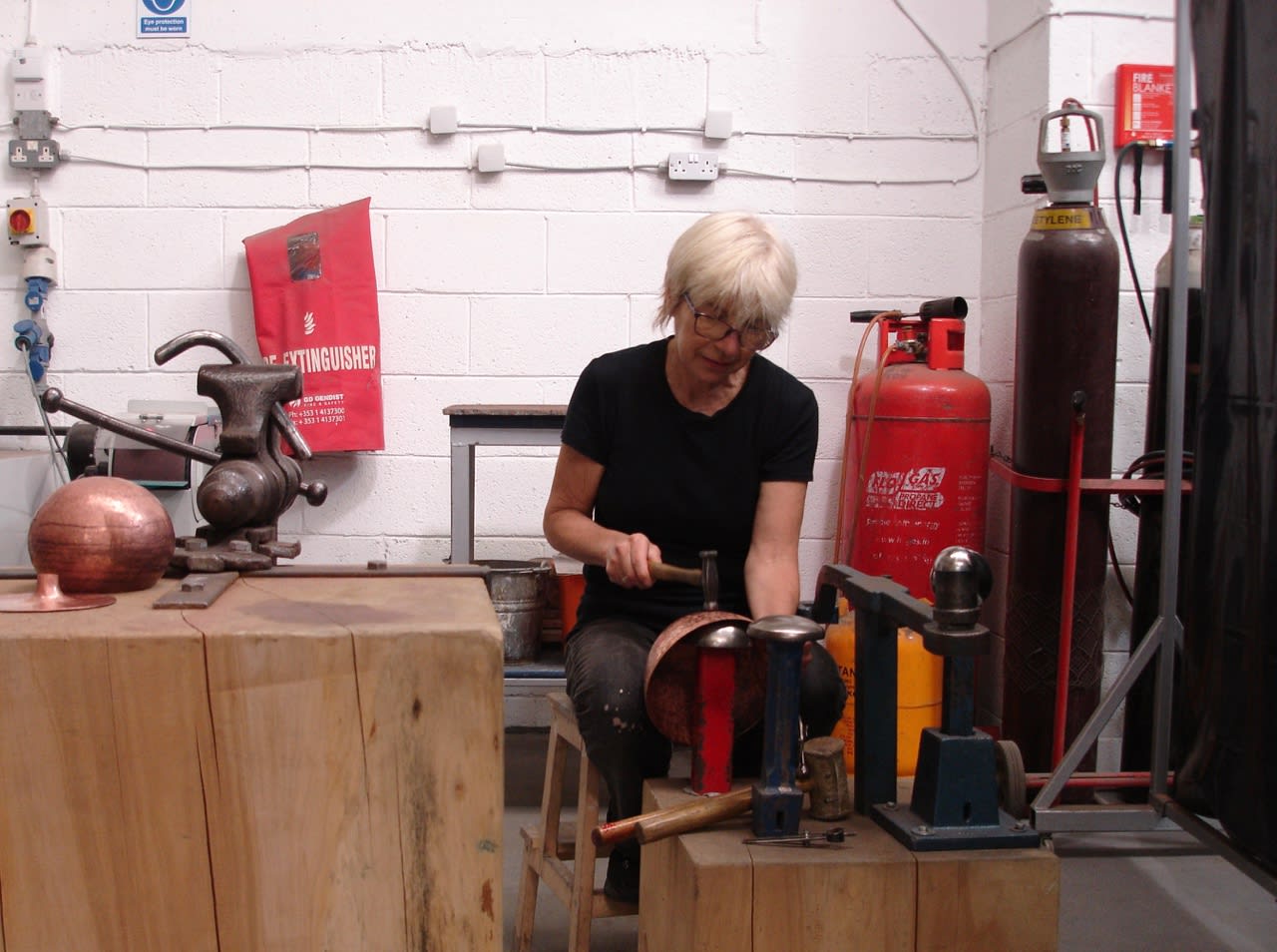
Cecilia in her studio at work
Cavaliero Finn:
You have a Masters and a First Class Honours Degree in Metal Design from the National College of Art and Design in Dublin, you studied Silversmithing in Birmingham and Dinanderie in Paris – it’s fair to say you have spent a long time learning about metal. When did your interest in metal start and why did you choose that as a material to work with?
Cecilia Moore:
When I was very young my best friend’s Mum was an artist, she had an enamelling kiln and let us do some enamelling, my friend wasn’t interested but I was smitten. I got to do metalwork at school and would spend days at the back of the metal room working on my own projects, skipping other classes, the metalwork teacher just let me get on with it.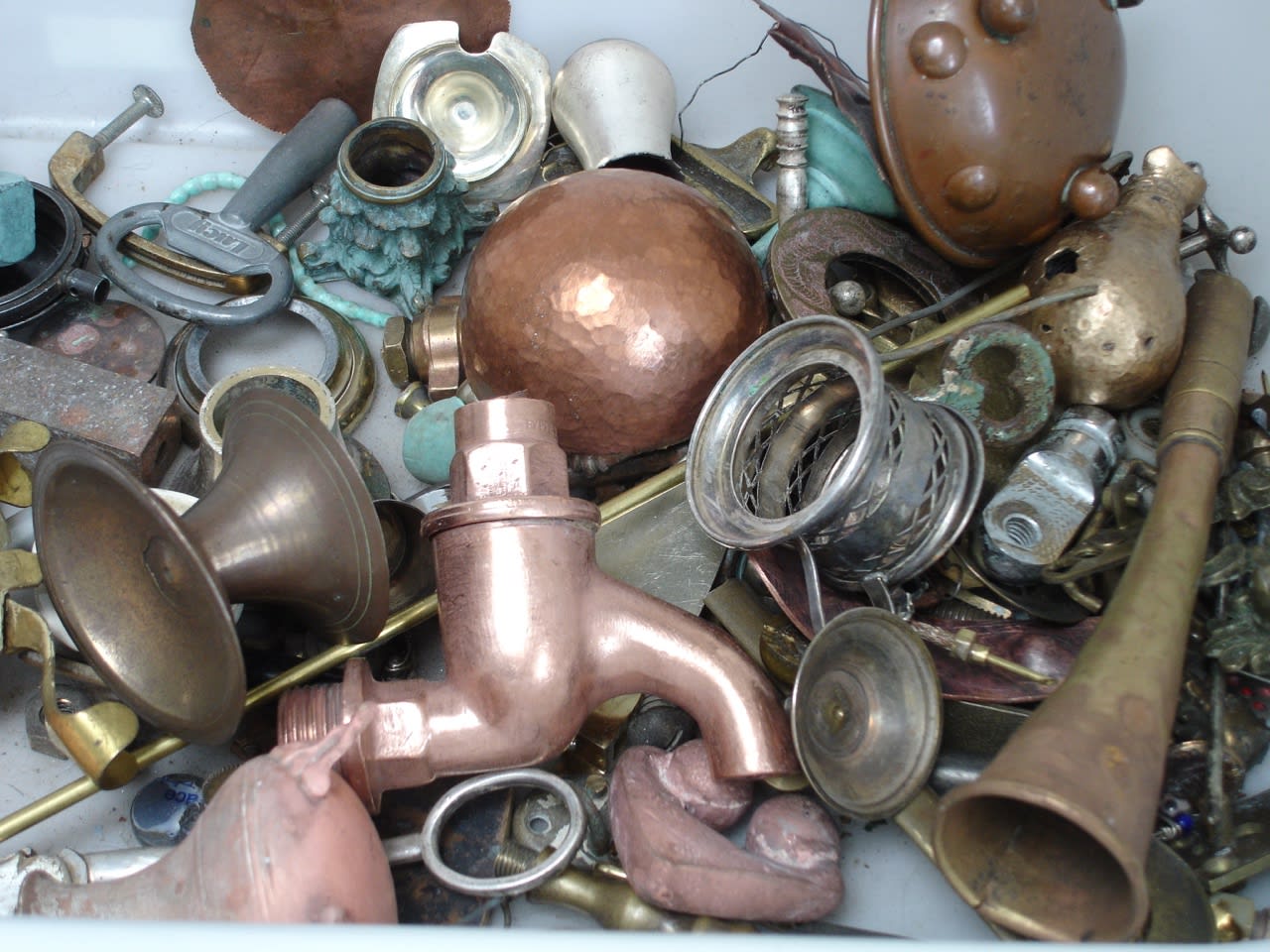
“I come from a family of gatherers growing up knowing everything will come in handy one day.”
Cecilia has a vast collection of found objects which find their way into her work.
CF: You often use found objects in your sculptures what attracts you to these and how do you work with them?
CM: I come from a family of gatherers growing up knowing everything will come in handy one day. So I have collected bits and pieces since childhood and inherited my family’s and friends’ hoards too, so each object has a history and often an emotional attachment. Depending on the object I often dismantle them, reassemble different parts and photograph the combinations, in 2012 I had so many photographs I started to make them into animations. These objects are combined with raised forms, like Parlour Life the arrangement of the found objects creates the theme, it is more than just recycling of found parts, it is revaluing, creating a new story, an unexpected new life.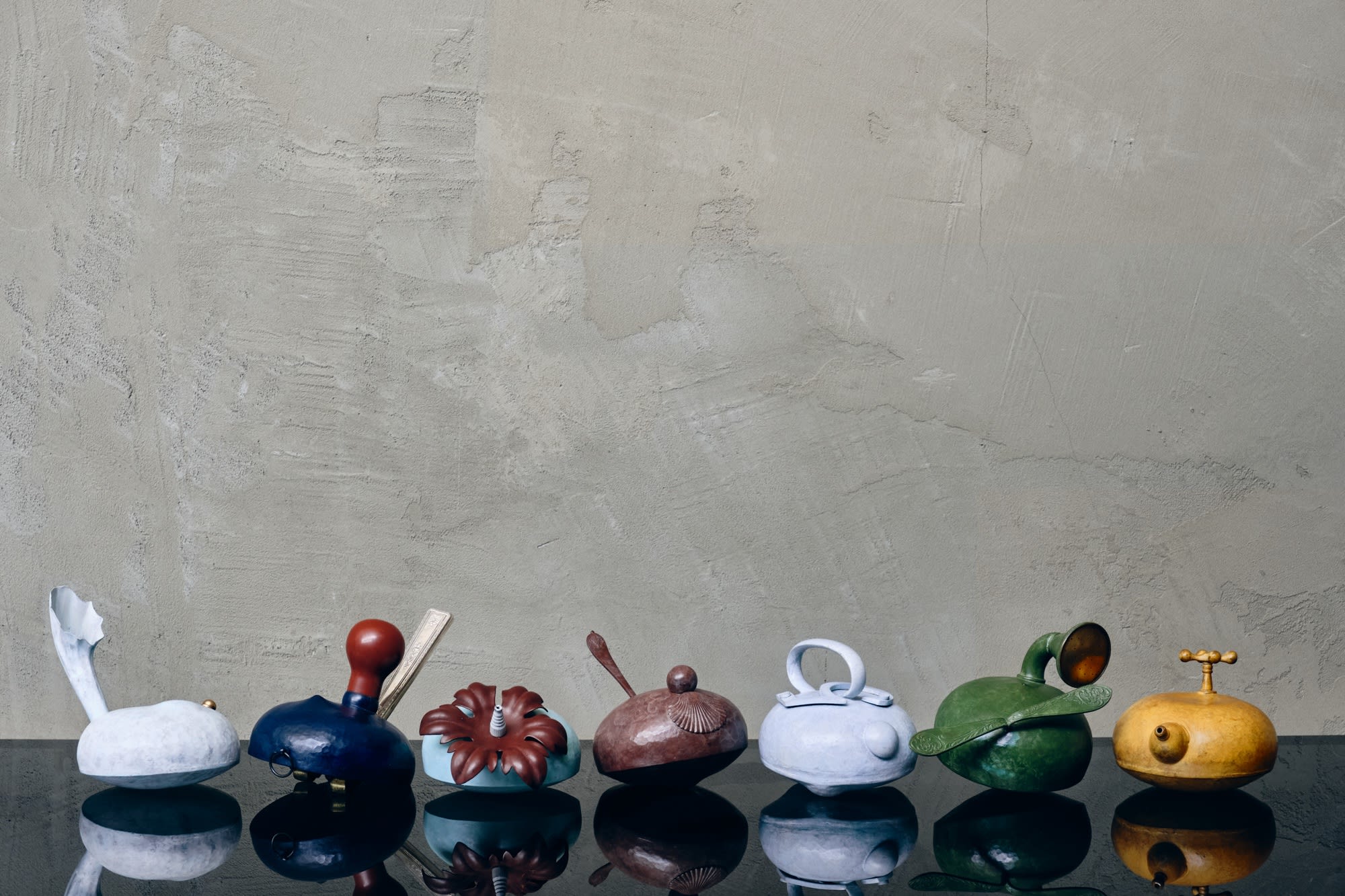 Parlour Life – 7 piece sculptural installation. Gilding metal, copper, bronze, found objects: silver, rubber, brass, epns – raised, constructed, soldered, patinated, each piece approx 6 x 11 x 11 cm + all components. Image: Ben Anders for Crafts Council Collect at Studio Cox.
Parlour Life – 7 piece sculptural installation. Gilding metal, copper, bronze, found objects: silver, rubber, brass, epns – raised, constructed, soldered, patinated, each piece approx 6 x 11 x 11 cm + all components. Image: Ben Anders for Crafts Council Collect at Studio Cox.CF: Can you tell us about the patination process and how you achieve such incredible colours in your sculpture?
CM: I use traditional patination techniques and ingredients and work up layers very slowly with the blow torch, when it goes right it feels like painting, but it often goes off track and I have to stop, clean back the whole piece and start again, despite this I enjoy the process and constantly learn from it.Interacting with Cecilia Moore’s playful metal sculptures Precarious II and Bam Bam at
Crafting a Difference – London Art Fair Edition
(Excerpt from video by Bruna Amaral at SoShiro, London)CF: What thought processes came about with the pieces that we have on show?
CM: The pieces you have on show are perhaps representative of my different thought processes and influences. Precarious II and Bam Bam, as well as playing with balance and movement, relate in form to the Irish Bronze Age gold work, particularly the dress fastners and torcs. The collection is held on the ground floor of the National Archaeological Museum in Dublin, it is a place I very frequently visit (before lockdown) to just stand and look in wonder at the gold pieces, it is a place to find stillness, connection and inspiration.
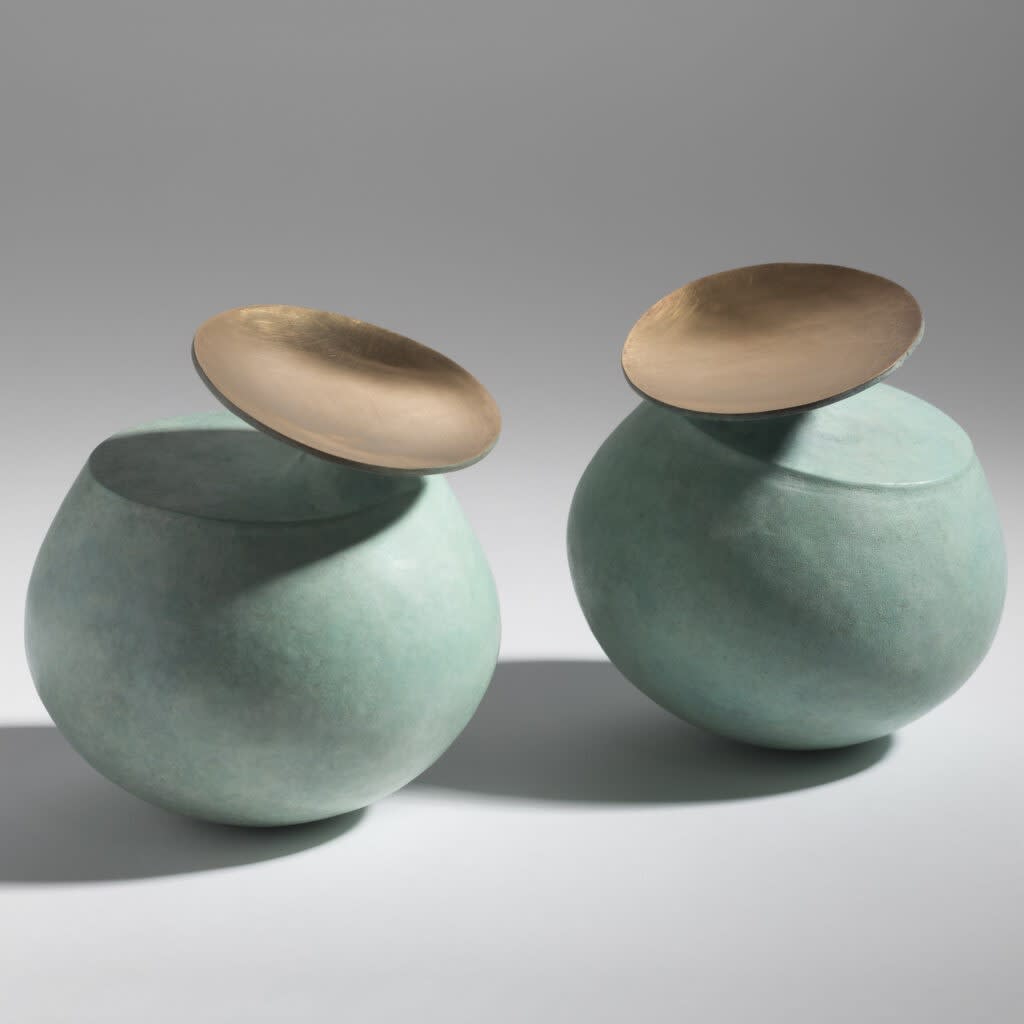
Cecilia Moore: Bam Bam, Sheet bronze, techniques: raisied, soldered, patinated, h14 x 12 x 12cm, 2017
CM: Parlour Life and Balancing Act I and II came from joy in raising (the hammering process I use) as well as ideas of play, colour, balance and movement. For Balancing Act I and II, Morandi’s gentle still lifes influenced me, I like the way he uses the same ordinary forms, just changes the arrangement or the combination and the taller pieces are often painted tilting, Balancing Acts incorporates these elements in the work, giving the audience the chance to make the still life.
Parlour Life [featured at the start of this post] continues from other similar work, Shed Life and A Dressed Up Life. These seven pieces use found objects from home to reimagine games and characters, I wanted to make the piece purposefully playful.
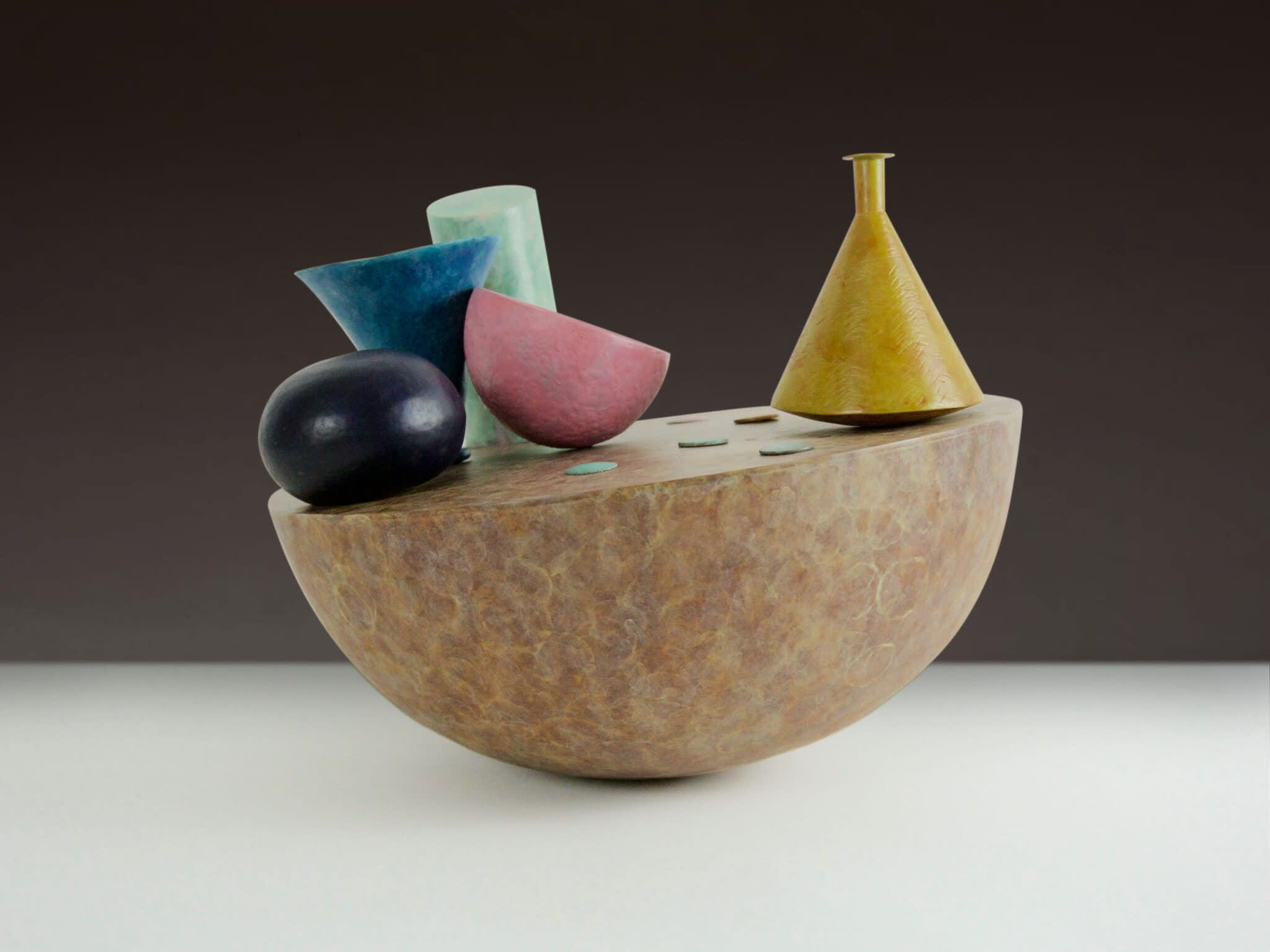
Balancing Act I – Copper, brass, bronze,”nickel silver”
Techniques: raised, soldered, constructed, etched, engraved, patinated.
Components: copper bowl, 7 top pieces, 7 pins, comes with a mahogany stand to store the pieces.Dimensions: diam 26 x h.11cm + top pieces h.5 -14cm, wooden stand: 30 x 9 x 9cm
CF: There’s a very playful feel about your work. Can you tell us a bit about this and why it’s important to your work?
CM: I work in a way I have dreamed of doing for so many years, it makes me so happy that I want my work to reflect this. I want the work to make people smile when they see its playfulness, the bright colours and its wobbles, to enjoy engaging with it, as a brief interlude to the serious stuff of life.Cecilia Moore – Balancing Act I
Excerpt from a video by Bruna Amaral of Crafting a Difference exhibition at SoShiro, LondonCF: You have been a big fan of sci fi since childhood. Can you tell us a bit more about this and comment on how this has shaped your work?
CM: I work very intuitively so often the original idea I start with evolves. I have collections, like a reference library in my head of shapes and images that I draw on. Many refer to imagery of my childhood in the 60s, a time lost in space, flying saucers and a blurring of sci fi or a future world. This imagery sometimes envelops my work and takes off to create strange pieces.
The Robot with Jonathan Harris as Dr. Smith in the sixties TV series Lost in Space
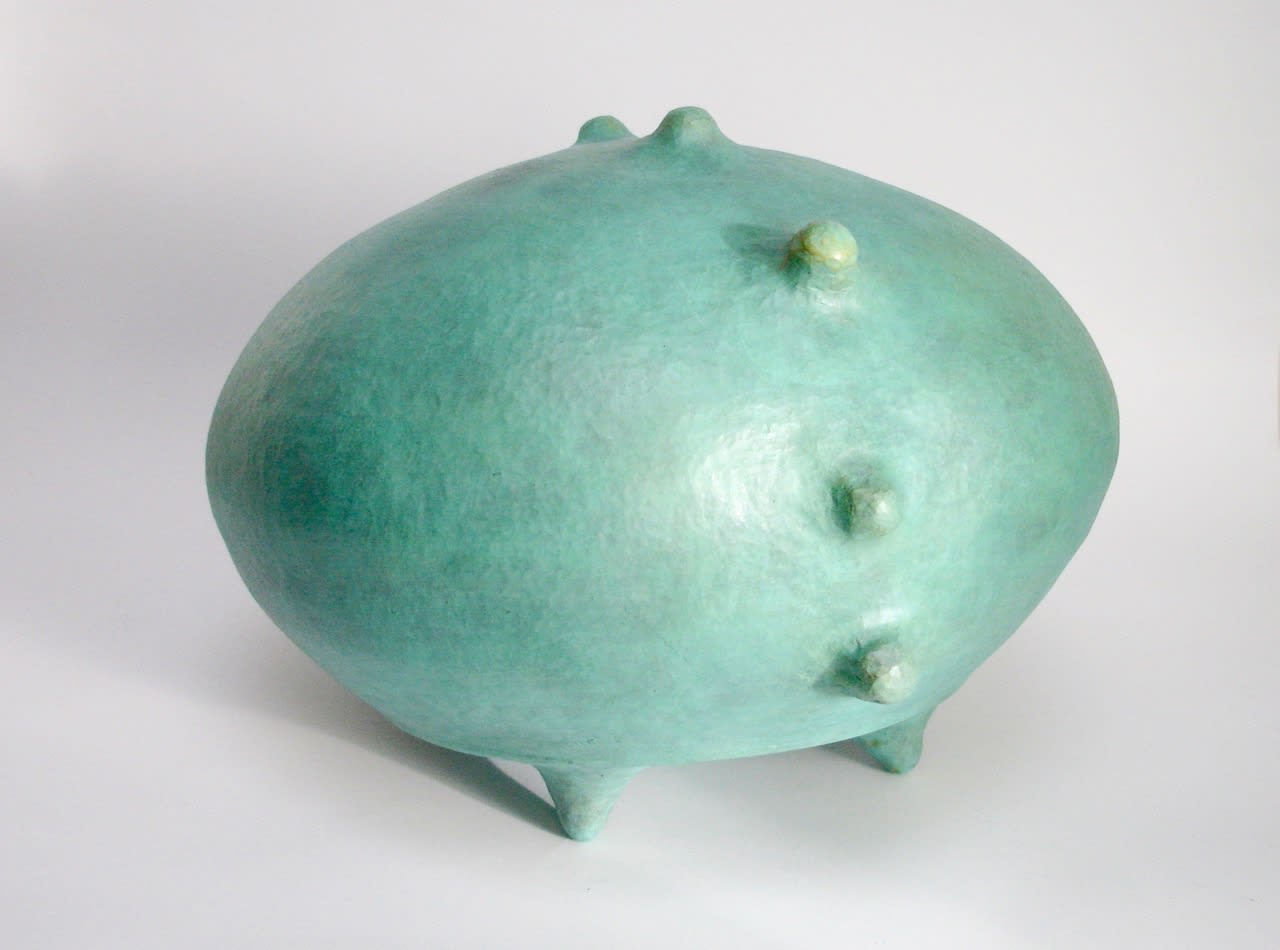 Cecilia Moore – Green Strut
Cecilia Moore – Green Strut CF: Which artists do you most admire?
CM: I admire so many diverse artists; Hieronymus Bosch for his bizarre and beautiful forms and detail of incidental objects, the stories within stories, Pieter Bruegel too; Rene Magritte for the unexpected; Heath Robinson for his drawings of ludicrous inventions. Sculptures by Franz West for their form, colour, playfulness and engaging an audience; William Turnbull for his play on balance. Louise Bourgeois for her tenacity, variety of forms and material and her honest expression as a woman. Marianne Brandt a designer / silversmith in the Bauhaus for her simplicity of line.
Bernd Becher and Hilla Becher for their industrial photographs particularly the water towers. Giorgio Morandi for his gentle still life of ordinary things, his colour palette, and his simplicity in life.
The work of the Bronze age Irish goldsmiths in The National Musesum’s Archealogical section is a constant source of inspiration and wonder for me.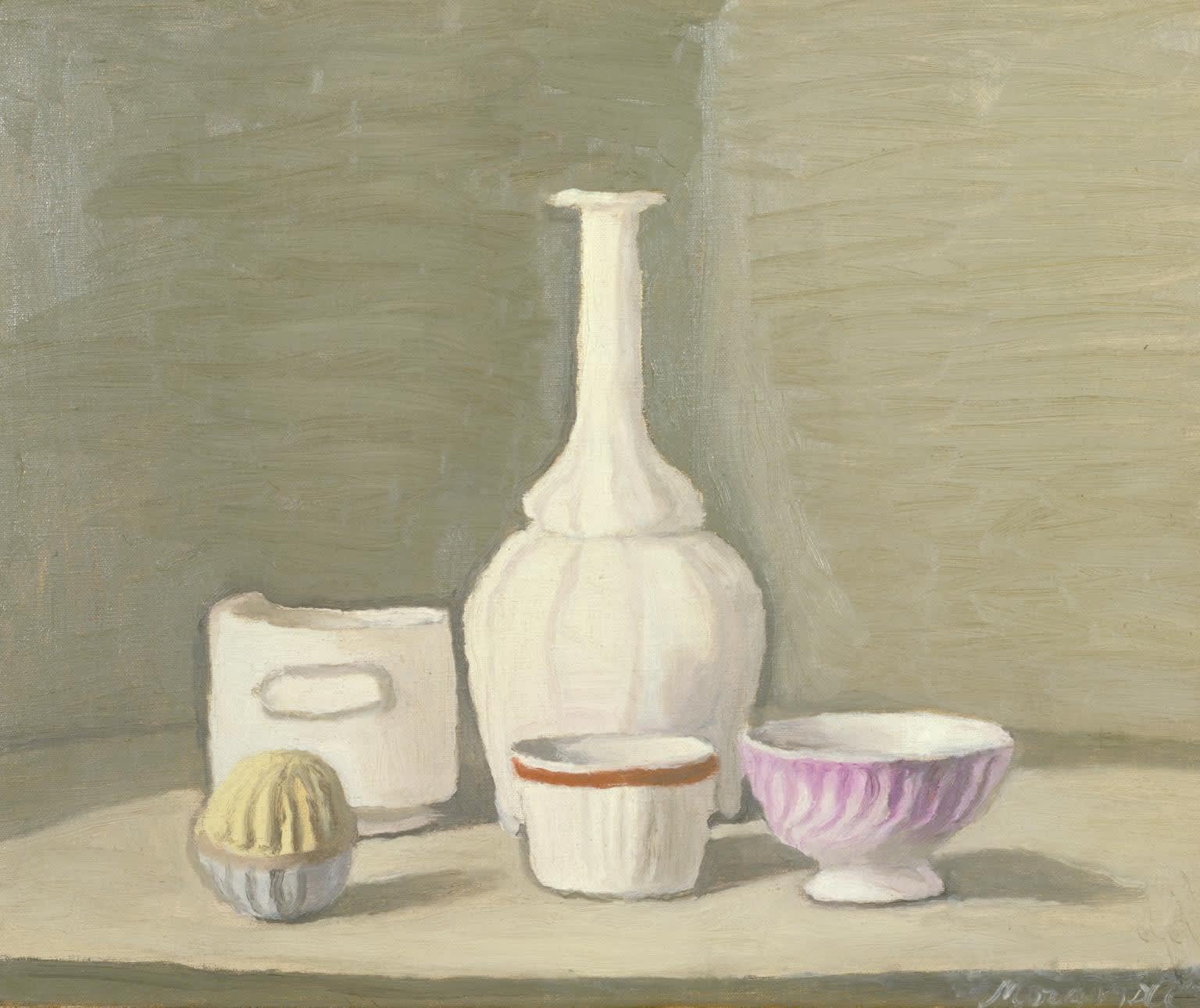
Still Life 1946 Giorgio Morandi 1890-1964 Presented by Studio d’Arte Palma, Rome 1947
“For Balancing Act I and II, Morandi’s gentle still lifes influenced me, I like the way he uses the same ordinary forms, just changes the arrangement or the combination and the taller pieces are often painted tilting, Balancing Acts incorporates these elements in the work, giving the audience the chance to make the still life.” Cecilia Moore

R to L: Balancing Act I and II, 2020
Balancing Act I – Copper, brass, bronze,”nickel silver”
Techniques: raised, soldered, constructed, etched, engraved, patinated.
Components: copper bowl, 7 top pieces, 7 pins, comes with a mahogany stand to store the pieces. Dimensions: diam 26 x h.11cm + top pieces h.5 -14cm,
wooden stand: 30 x 9 x 9cm
Balancing Act II – Copper, brass, bronze, mahogany
Techniques: raised, soldered, constructed, etched, engraved, patinated.
Components: copper bowl, 8 top pieces, 8 pins, wooden stand.
Diameter 30 x h14.5cm + top pieces h.5-14cm.
wooden stand 30 x 9 x 9cmCF: Has the lockdown made you look at your work/approach your work differently and if so, why?
CM: Yes, last year the time in my workspace was very limited and, as I had some important exhibitions to make work for, I had to be focused and very organised . Unfortunately the workspace has now been in lockdown since December and working from home has many challenges for me living in a flat. I can do no hammering for starters, but I can patinate and construct small pieces. I have no raised forms to unify ideas, so am dependent on my hoard of found parts, it has been challenging but I keep making, using a smaller scale, and a thought process that is definitely lost in space somewhere. You are the first earthlings to see the new work.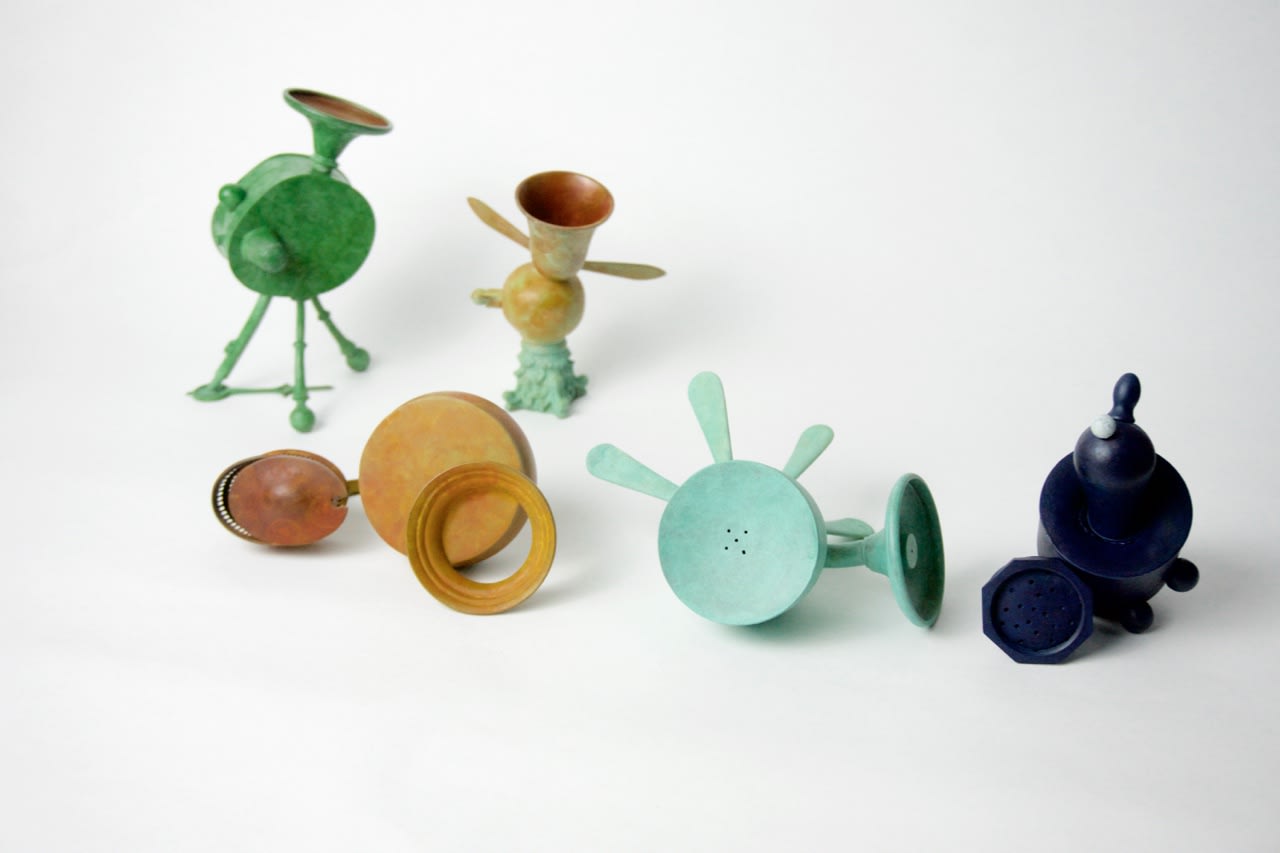
Masheens – new work by Cecilia Moore
-
Like Cecilia Moore, sculptor Simon Gaiger also works with found objects but instead of being objects handed down from family members and friends like Cecilia’s, the objects Simon works with are those that lay redundant in the hedgerows and land surrounding the old farmhouse that is his home, near Llanybydder in Carmarthenshire, one of the oldest occupied counties in Wales. Working in metal and also in wood, Simon’s sculptures are simultaneously human and landscape, narrative and abstract. They are influenced by the layers of the eclectic life he has led; a peripatetic childhood spent in Uganda, Sudan, Papua New Guinea, Vanuatu and the Falkland Islands, time spent working as a shipwrights assistant, fuelled by his interests in the sea, engineering, history and mythology. All of these past experiences work their way into his drawings and thoughts collected over many years, scribbled down the in piles of black and grey sketchbooks that fill his home.
Working with industrial materials, redundant and left to decay on the land, Simon transforms them in such a playful way that their industrial or agricultural origins become almost invisible.
Simon works closely on projects with architects, interior and garden designers in the UK and internationally including Studio Reed, Dan Pearson, Küchel Architects, Peter Mikic, Rui Ribeiro, Arne Maynard and Ilse Crawford. He is a member of the Royal Society of Sculptors.
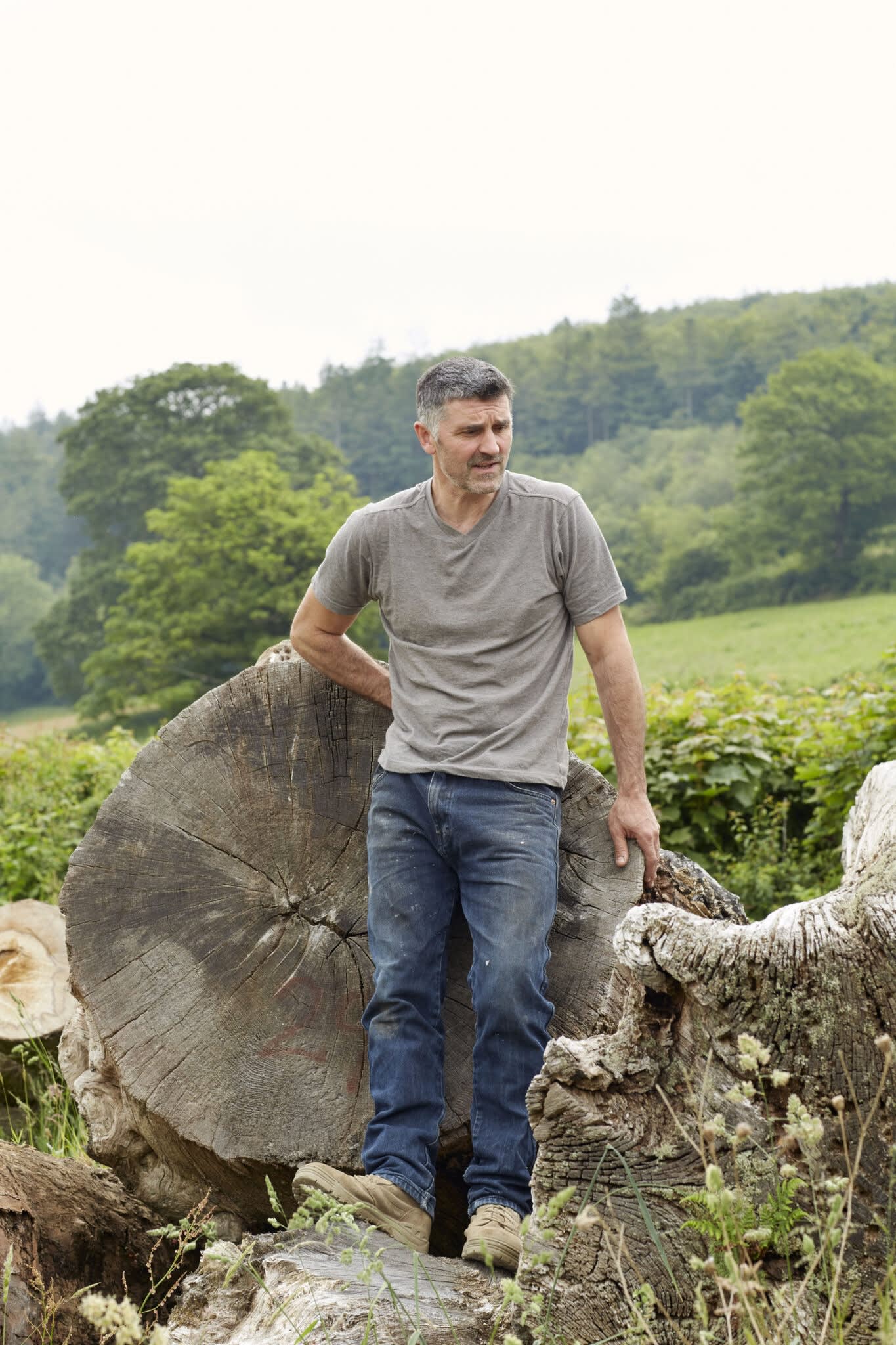
Simon Gaiger
Cavaliero Finn: You have lived in Africa, the South Pacific and The Falkland Islands, have these locations influenced your work?
Simon Gaiger: Spending my ‘formative’ years in Africa and the South Pacific has influenced me deeply. It has instilled a belief that artistic expression is a natural, everyday facility for all people. Everyday domestic objects as well as sacred objects are imbued with life in form and decoration. Abstraction is second-nature and there is little distinction between art and craft. The link to our ancient, primaeval symbols and forms is also much closer in Oceanic and African art. Vital, more direct, expressive and often complex although sometimes perceived as less ‘sophisticated’ in the knowing sense.
Technically Africa, New Guinea and Vanuatu have a strong tradition of making skills. Pangas, axes and adzes form shapes in wood, deep hollows are burnt out and surfaces charred, oiled and limed. A usually simple palette of earth pigments highlight surface pattern.

Simon Gaiger: Harness, forged, welded, painted steel, 68 × 48 × 30.5 cm 2020
“Created during the lockdown, with Harness, I was revisiting an idea of pulling force against a resistance force – working to drag a weight – moving forward under load. It tries to express the things that need doing around us and the difficulty in doing them”
CF: Having travelled extensively in the earlier part of your life, what is about the remote part of Wales that has kept you in the same place for nearly 20 years?
SG: I make a lot of pieces about myths and about man in nature – it feels like this old glebe is a place by the river that has been held and lost by people since ancient times. At one time the Manchester and Milford Railway came through our land – now a tract of trees. As a smallholding, it’s a practical space also that allows me to make work.

Sculpture in the landscape, this brighly coloured sculpture was created by Simon to support a leaning blackthorn tree.
CF: You have worked as a shepherd, a shipwright and in landscape construction, have these experiences informed your sculpture and working methods?
SG: Yes – definitely. These jobs are mostly hard, physical work. The realisation of sculpture is also mostly hard work and similar disciplines are needed to see the work through. Construction methods, techniques, joins and even the ways of handling large logs transfer from the landscaping and shipwrights world to sculpture. Also familiarity with hand tools, adzes, axes, chainsaws and welding come from these trades. Forms and visual languages are also transferable – for instance, the curves and shapes of boats are closely related to smaller domestic vessels.
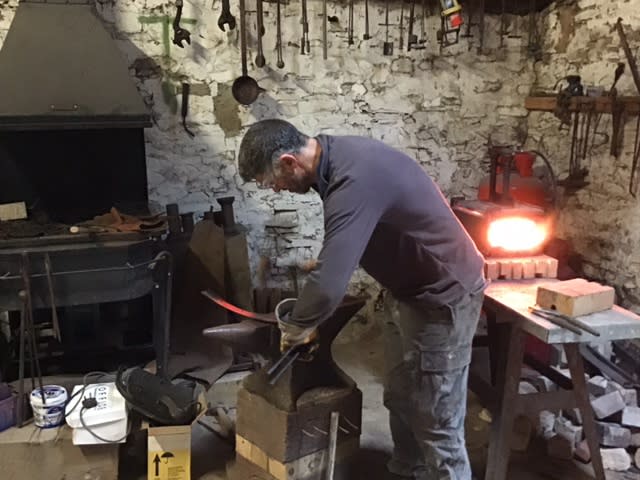
CF: What made you turn to found objects as major components for your work?
SG: They’re the things around us that reflect our lives – as material for art they are beyond their original use or broken pieces that are free to use in another guise. Found objects harness the instinctive childlike response to anthropomorphize – to give a new life to a fragment and to enjoy sharing the recognition of that translation with other people or the pleasure of disguising it from them. Taken out of their original context found objects provide powerful abstract elements.
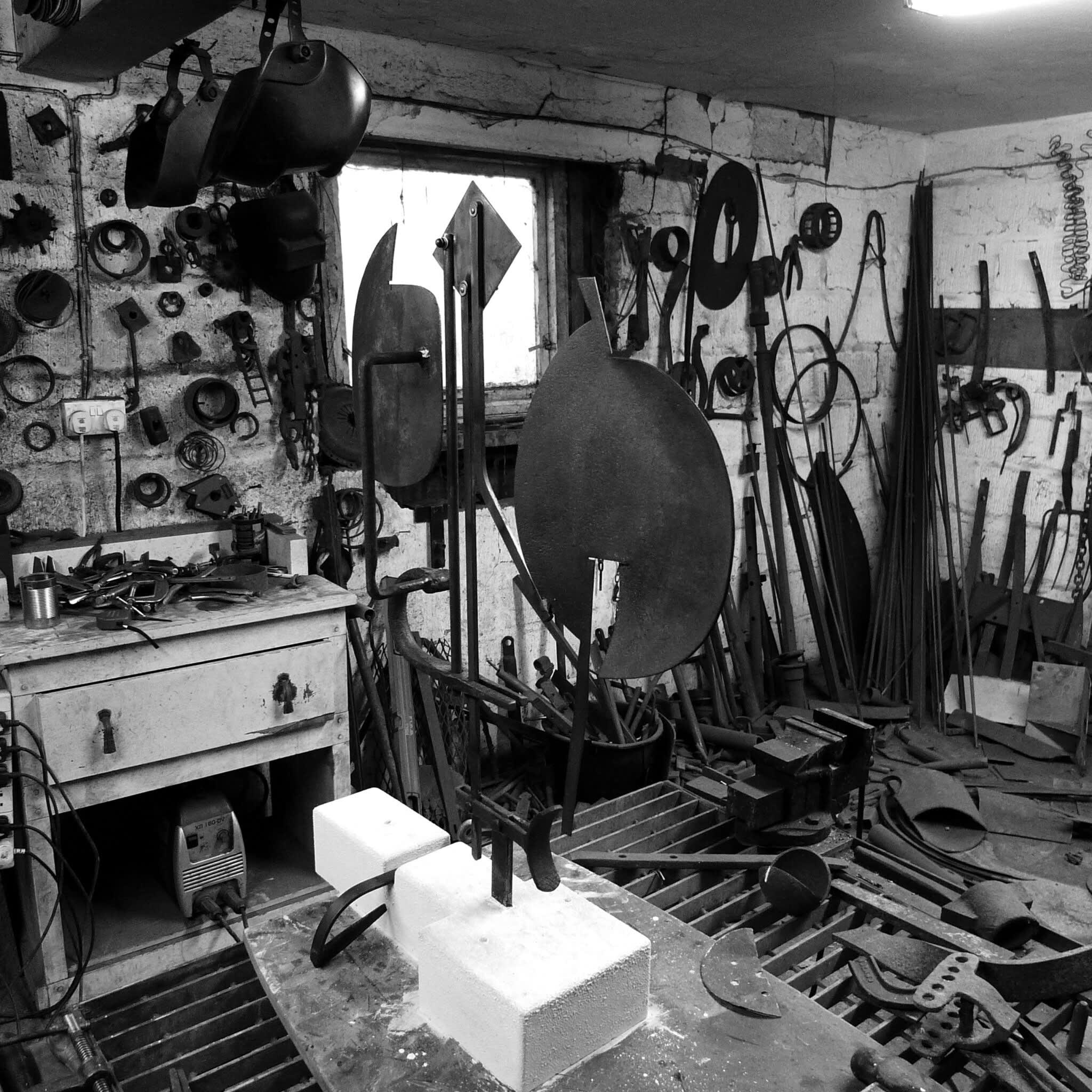
Work in progress in Simon's studio
CF: When did you make your first sculpture from found objects?
SG: As a small boy in Uganda my friends and I would make toys from tins to race around in the dust.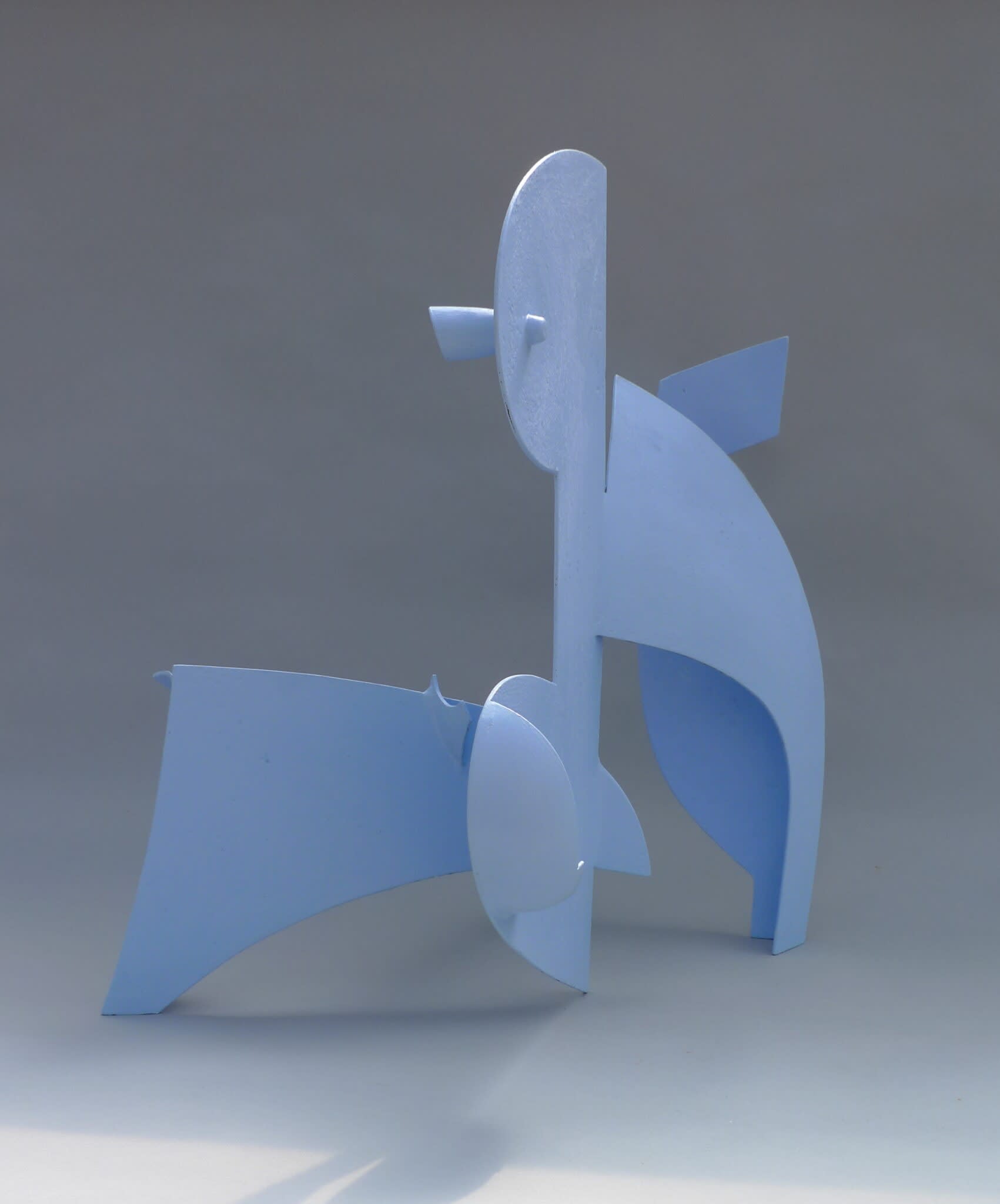
Simon Gaiger: A Kind of Blue – forged, welded, painted steel 60 × 58 × 36 cm 2020 (Sold)
Highlighted in Erik H. Neil’s Curated Selection from Collect 2021
CF: You once said that there are conscious/deliberate decisions in arrangement. How do you decide which elements go with which when designing and assembling your sculptures? Do you design the sculpture on paper and then find the elements to make it come alive or do the elements find you and make the sculpture?
SG: Both – I think the process is circular and can be entered at any point. Often I have a clear feeling for a finished piece and try to transpose this into metal or wood, resolving detail during the making process. Other times pieces evolve from a central element in a more searching process.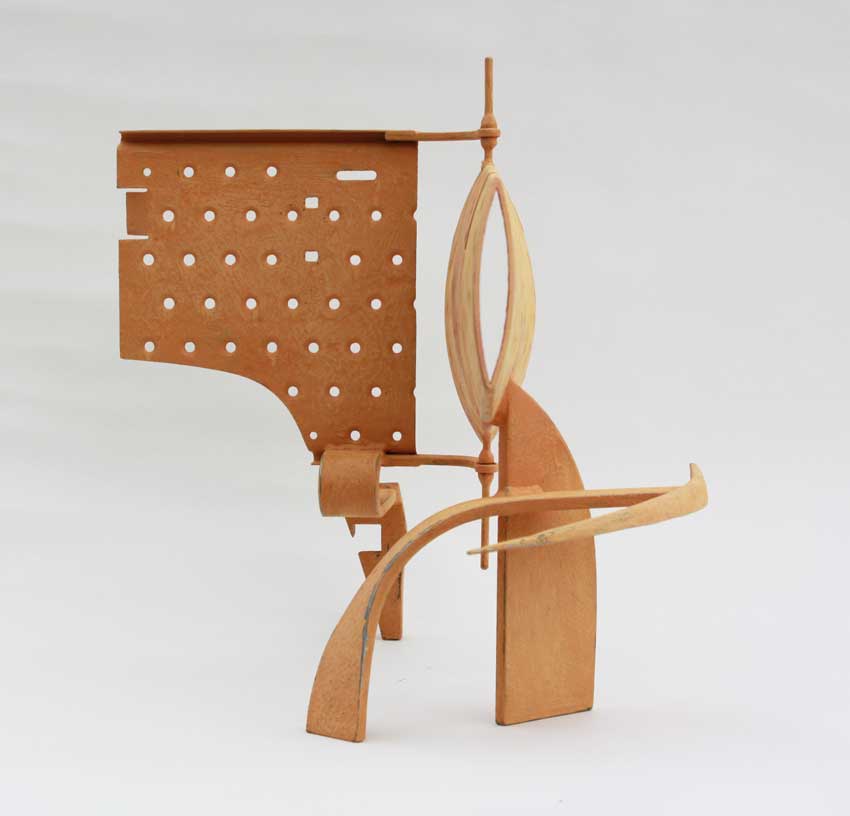
Mistress of the West – forged, welded and painted steel, L 71 x H50 cm, max width 315-500mm, 2017 (Sold)
SG: ‘Mistress of the West’ has a tractor tread plate as a main element. This sat in my shed window for a while with the light shining through it – it reminded me of a mashrabiya and of the ceilings in the Habu temple in Luxor and started the whole process of making a piece about Hathor and the heat and sun of Egypt.
CF: Your work has a very playful quality to it, inviting people to interact and move pieces around. Why is this important to you?
SG: Working for me is quite a solitary process and whilst I’m not necessarily thinking of a particular response a viewer might have of the finished work – I’m aware of their presence and want to make a connection that engages and involves. Including moving parts or elements that can be re-arranged is a way of inviting people in to complete the piece, it also means that every physical interaction by a viewer is a collaboration that forms a particular iteration that is a unique relationship between that person and the maker. Each new viewer then sees a piece that has been affected by a decision and action that the previous viewer has made. (I’m basically trying to get other people to make my mind up for me!)
Apotropaic Device – forged, welded, painted steel with interchangeable units, 75 x 55 x 22 cm, 2020
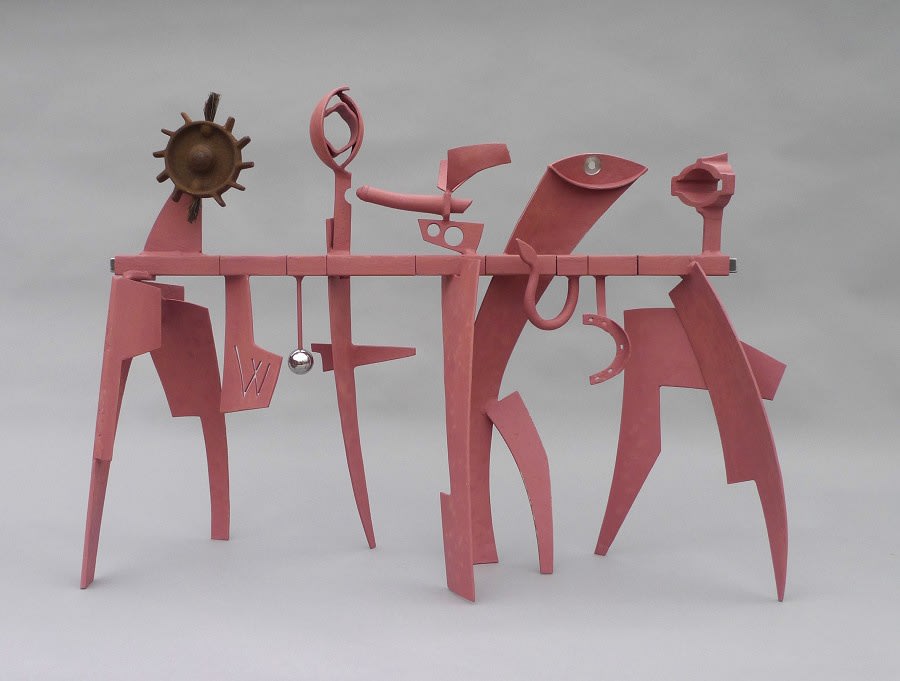
Apotropaic Device – forged, welded, painted steel with interchangeable units, 75 x 55 x 22 cm, 2020

Apotropaic Device – forged, welded, painted steel with interchangeable units, 75 x 55 x 22 cm, 2020
CF: Your titles are interesting. Can you tell us about the use of titles for your works?
SG: Titles can work in many ways – sometimes something heard, read or seen triggers the making of a sculpture in response, other times a title is chosen later to highlight an aspect or feature or characteristic of a finished work.
Apotropaic Device (featured above) deals with our basic human response to try to ward off threats – illness, evil, bad luck by resorting to superstitious habits to protect ourselves. (just in case – it can’t hurt…. the not stepping on the cracks). We have ‘witch marks’ scratched into the stone door surround in our old house. Horseshoes, all-seeing eyes and flying penises* (*etym ‘fascinating’) – it would be interesting to know which talisman and what arrangement of this piece are most effective against which threats!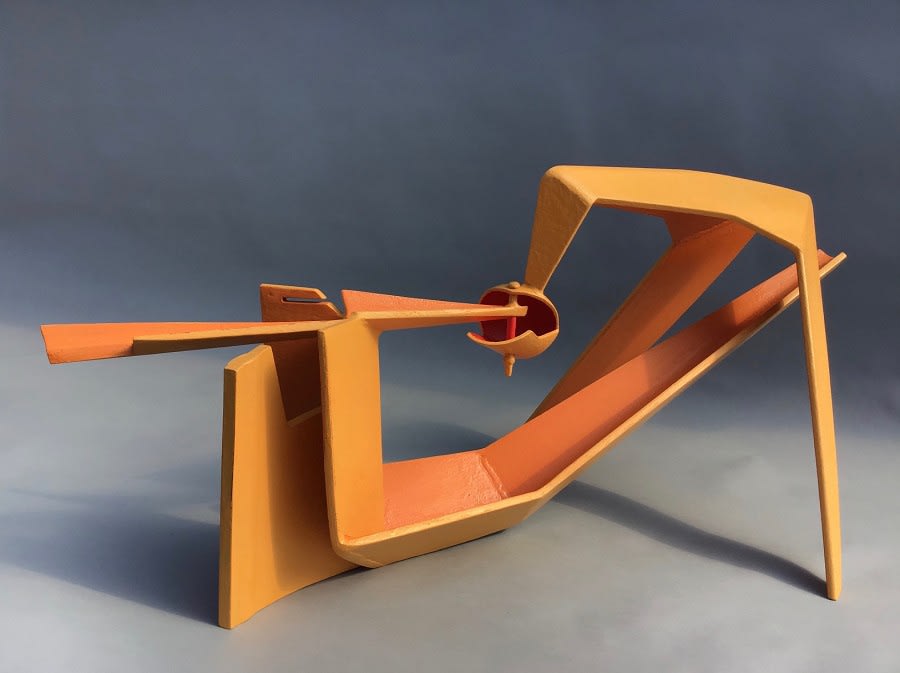
Simon Gaiger – Wilhelm Scream, forged, welded, painted steel, 90 x 40 x 45 cm, 2020
SG: With Wilhelm Scream, it was inspired by a particular way I was feeling at the time. During this quarantine, there was a feeling that many of us were screaming internally and externally and for many personal and societal reasons. I thought of a universal scream sampled to represent this pain. This is of course reductive and perverse in the sense that it doesn’t express our individual feelings – becoming just a symbolic generic noise. The Wilhelm scream was recorded for the 1951 film ‘Distant Drums’ and has featured ever since in action films (and in any other film the sound engineers can sneak it into!) An alternative title for the sculpture would have been, “Man getting bit by an alligator, and he screamed.”
CF: How do you choose your colours for each sculpture and how is it applied practically?
SG: Colours are either obvious or hard to choose depending on the nature of the work. I often paint several layers of different colours by hand and then rub each coat back so that some of the underlying colour shows through. I also vary tones of colour on different facets of a piece.
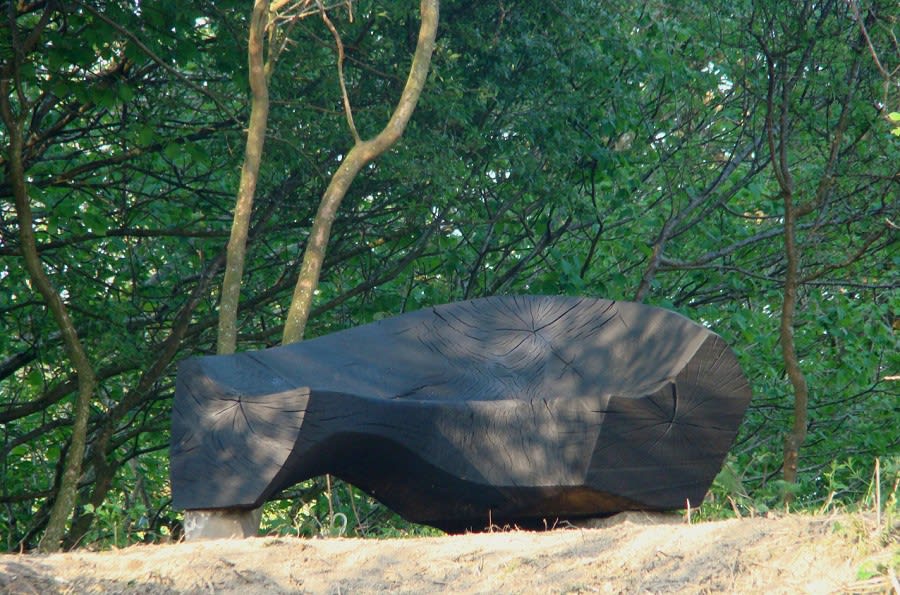
Simon Gaiger: Teifi Seat, Charred Oak
CF: Your work encompasses wood as well as metal, what is it about these two materials that interests you?
SG: In practical terms metal and wood are the materials I can get hold of and have developed the skills to use so I’m able to realise ideas more easily with them. Whilst their characteristics do have some overlap – metal suggests to me a manmade element that can be bent to your will whilst wood, especially in its raw state, displays its nature and asks to be steered. When used together, I find metal can make the practical links that frees the wood for its expressive nature and inherent forms.Cavaliero Finn is featuring both Simon and Cecilia’s work at Crafting a Difference Collect Edition at SoShiro which runs now until April 30th 2021.
Curated by Brian Kennedy, Crafting a Difference at SoShiro – Collect Edition presents over 200 artworks by more than 70 artists from five leading galleries including Cavaliero Finn, jaggedart, MADEINBRITALY, Ting Ying and Vessel Gallery. The exhibition is supported by the Michelangelo Foundation and the Loewe Foundation.
It is hoped that we can take bookings to view the exhibition from April 12th.
